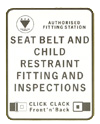It’s best practice to have the seat fitted approximately 2 weeks before your baby’s due date. This way you won’t get caught without a seat in the car if your baby arrives a little early and it also gives you time to familiarise yourself with how to use your baby’s seat.
We fit all Australian Standards approved seats that appear in good order, not just the seats we sell.
Most likely not. Because child seats are manufactured from plastic, this gives them flexibility in an accident to absorb impact energy for your child and to keep their restraining harness/seatbelt firm helping to keep them safe. As plastic ages it degrades and becomes more brittle losing its elasticity and potentially breaking up in an accident causing the child restraint to fail. Child safety restraint manufacturers will not guarantee the performance of their child restraints once 10 years has elapsed after manufacture.
When your child has turned 6 months of age and has reached the minimum shoulder height indicator for forward facing on your chosen seat. Most 0-4yr convertible car seats are labelled with an average 12 month shoulder height for forward facing, some even have approval to carry a child rear facing until the size of an average 3 year old.
Once your child has turned 4 years old and they have reached the minimum shoulder height requirement of your chosen booster seat. A booster seat fitted with an accessory child harness is not a legally approved seat for a child under 4 years old unless they have outgrown the largest fully harnessed seat available on the Australian market. (See Safe’n’Sound Maxiguard and Infa Secure Evolve type G seats – fully harnessed seats suitable for children up to the size of an average 6-8 year old.).
Australian law for children in child seats states that if your child still physically fits in the seat intended for younger children you are permitted to continue to do so.
In the same way as above, if your child is physically too big for the category of seat intended for their age then it is permitted to move them on earlier. Be careful to check whether your seat is labelled to the same height as other models of seat in the same category – they’re not all identical in their shoulder height labeling, some are considerably shorter and the seat you own may be one that is labelled lower than others. Moving your child up a category from a seat with a built in harness to a booster seat, reduces your child’s protection in an accident.
Product Safety Recalls Australia (kids equipment) – http://www.recalls.gov.au/content/index.phtml/itemId/952909/fromItemId/952867
ACCC Product Safety Australia – http://www.productsafety.gov.au/content/index.phtml/itemId/973889
Van seat FAQs from Techsafe seating website Techsafe Seating
What are the laws regarding child restraints in NSW?
All children must be safely fastened in the correct child car seat for their age and size. A child who is properly secured in an approved child car seat is less likely to be injured or killed in a car crash than one who is not.
Up to 6 months
Approved rear facing child car seat.
6 months to 4 years
Approved rear or forward facing child car seat.
4+ years
Approved forward facing child car seat or booster seat.
145cm or taller
Suggested minimum height to use adult lap-sash seatbelt.
- Children up to the age of six months must be secured in an approved rearward facing restraint
- Children aged from six months old but under four years old must be secured in either a rear or forward facing approved child restraint with an inbuilt harness
- Children under four years old cannot travel in the front seat of a vehicle with two or more rows
- Children aged from four years old but under seven years old must be secured in a forward facing approved child restraint with an inbuilt harness or an approved booster seat
- Children aged from four years old but under seven years old cannot travel in the front seat of a vehicle with two or more rows, unless all other back seats are occupied by children younger than seven years in an approved child restraint or booster seat
- Children aged from seven years old but under 16 years old who are too small to be restrained by a seatbelt properly adjusted and fastened are strongly recommended to use an approved booster seat
- Children in booster seats must be restrained by a suitable lap and sash type approved seatbelt that is properly adjusted and fastened, or by a suitable approved child safety harness that is properly adjusted and fastened.
If your child is too small for the child restraint specified for their age, they should be kept in their current child restraint until it is safe for them to move to the next level.
If your child is too large for the child restraint specified for their age, they may move to the next level of child restraint.

